Flavours are subtle and balanced, obtained through restrained use of seasoning and light-handed cooking techniques.
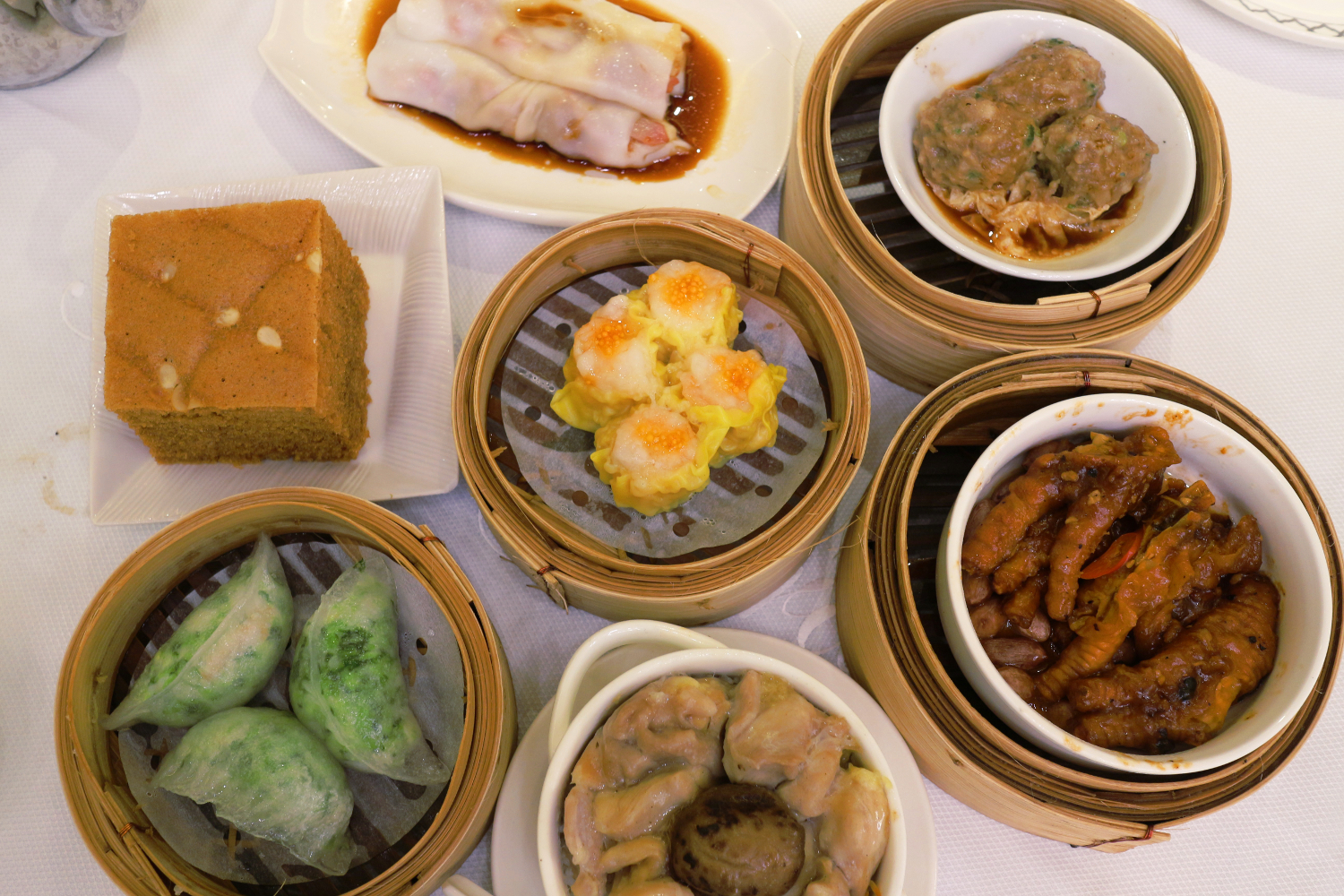
For years, Hong Kong’s chefs have influenced culinary trends in mainland China and chinatowns worldwide, and in recent years, quite a few have received recognition from the world’s leading authorities on dining. Here are some iconic dishes you should not miss on your trip to Hong Kong.
Its name translates literally as ‘to touch the heart’, and it's certainly the heartbeat of Hong Kong cuisine. Dim sum consists of bite-sized delights consumed with tea for breakfast or lunch in an act called yum cha (to drink tea). At Hong Kong's many dim sum restaurants, dumplings, buns, rolls and other delicious morsels – steamed in small bamboo baskets or fried – are paraded around in trolleys or served directly at the table.
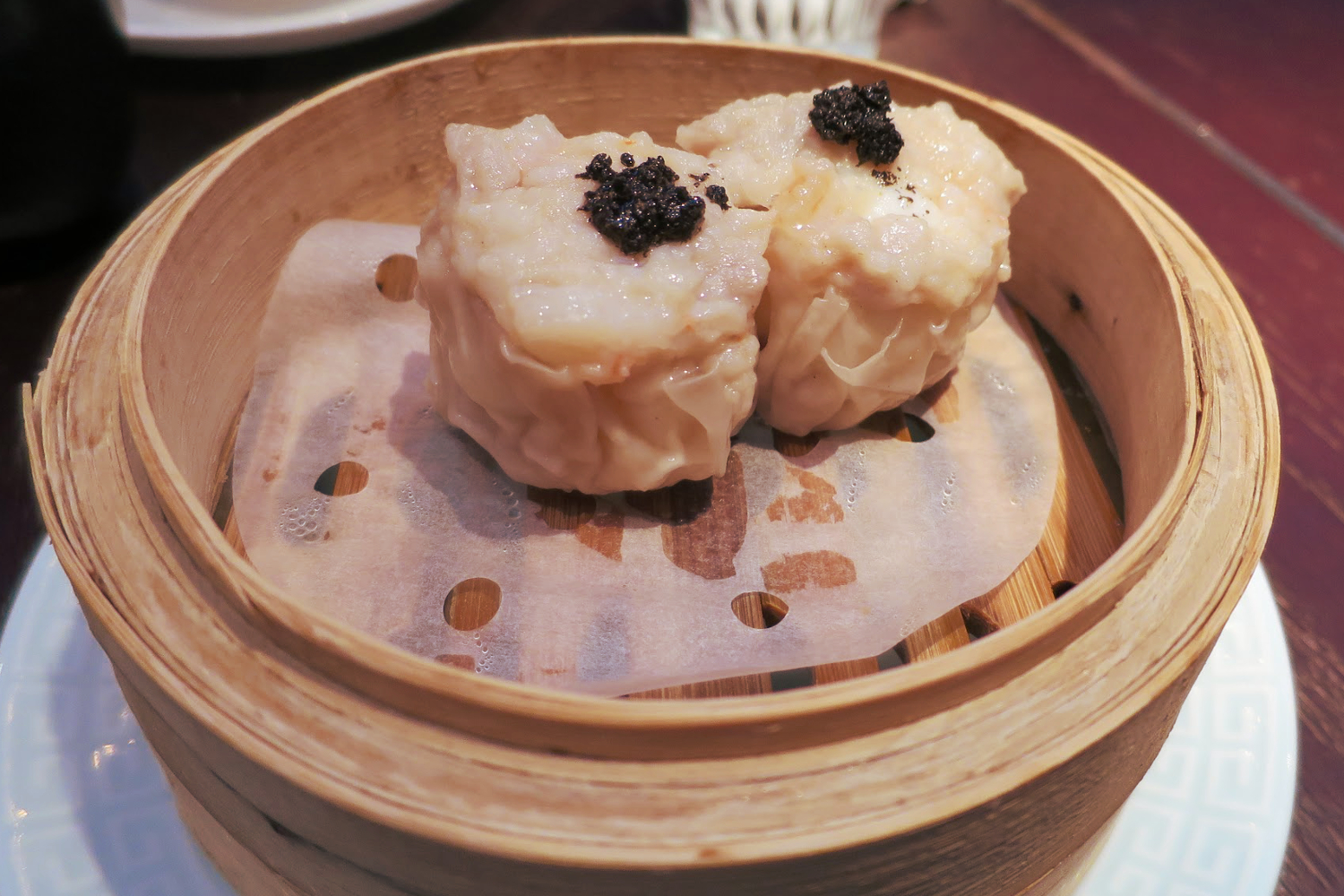
The classic shrimp dumpling (ha gao) is a baby’s fist of minced shrimp and bamboo shoot inside a translucent dough. Rice noodle rolls (cheung fun) are thin sheets of steamed rice flour embedded with seafood, meat or vegetables. The barbecue pork bun (tsa siu bao) features savoury-sweet pork encased in a fluffy white steamed bun, and sometimes, a flaky puff pastry or a golden glazed baked bun. Popular dessert dim sum can be a feathery steamed cake (malai go) made with fragrant Demerara sugar, or the customary egg custard tart, child of the Portuguese pastel de nata and the British custard tart.
Possibly Hong Kong’s most representative drink, yin yeung is an invigorating concoction of three-parts tea (Ceylon and pu’er) and one-part Robusta coffee. A bitter-sweet reminder of the city’s colonial past, it’s downed at breakfast or tea-time with generous lashings of evaporated milk. The coffee’s harshness is tempered by hints of spice and chocolate from the tea, while the milky creaminess rounds everything off. Yin yeung is a perfect companion to the ‘pineapple’ bun (bolaw bao), a fruit-less sweet pastry with a checkered-top crust that resembles the skin of a pineapple. It’s best served warm, with a slab of butter wedged between the bun’s two halves.
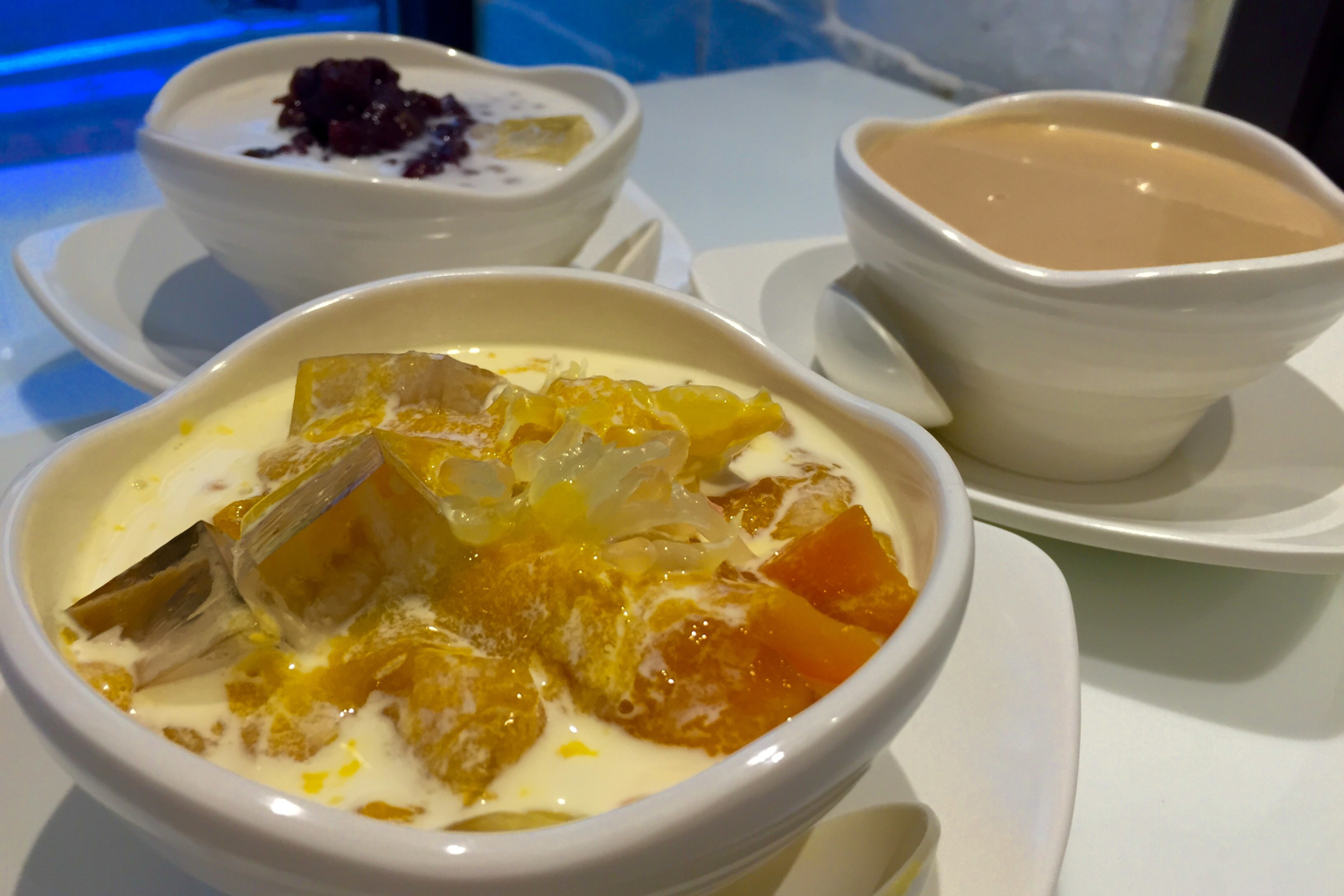
Sweet soups are a Cantonese speciality and nowhere are they as well-loved and colourful as in Hong Kong. Known as tong sui in Cantonese, these soups are consumed as a dessert or a late-night snack for their health benefits as much as their taste. At its base, the soup is made by boiling pulses, seeds and root vegetables with sugar. Black sesame, walnuts and almonds are ground and cooked into a nourishing gruel. Azuki beans are simmered with sun-dried tangerine peel, lotus seeds and cane sugar to form a chocolaty porridge; green mung beans and seaweed come together in a savoury soup. Tender chunks of yam bob in a sweet, amber consomme spiked with ginger.
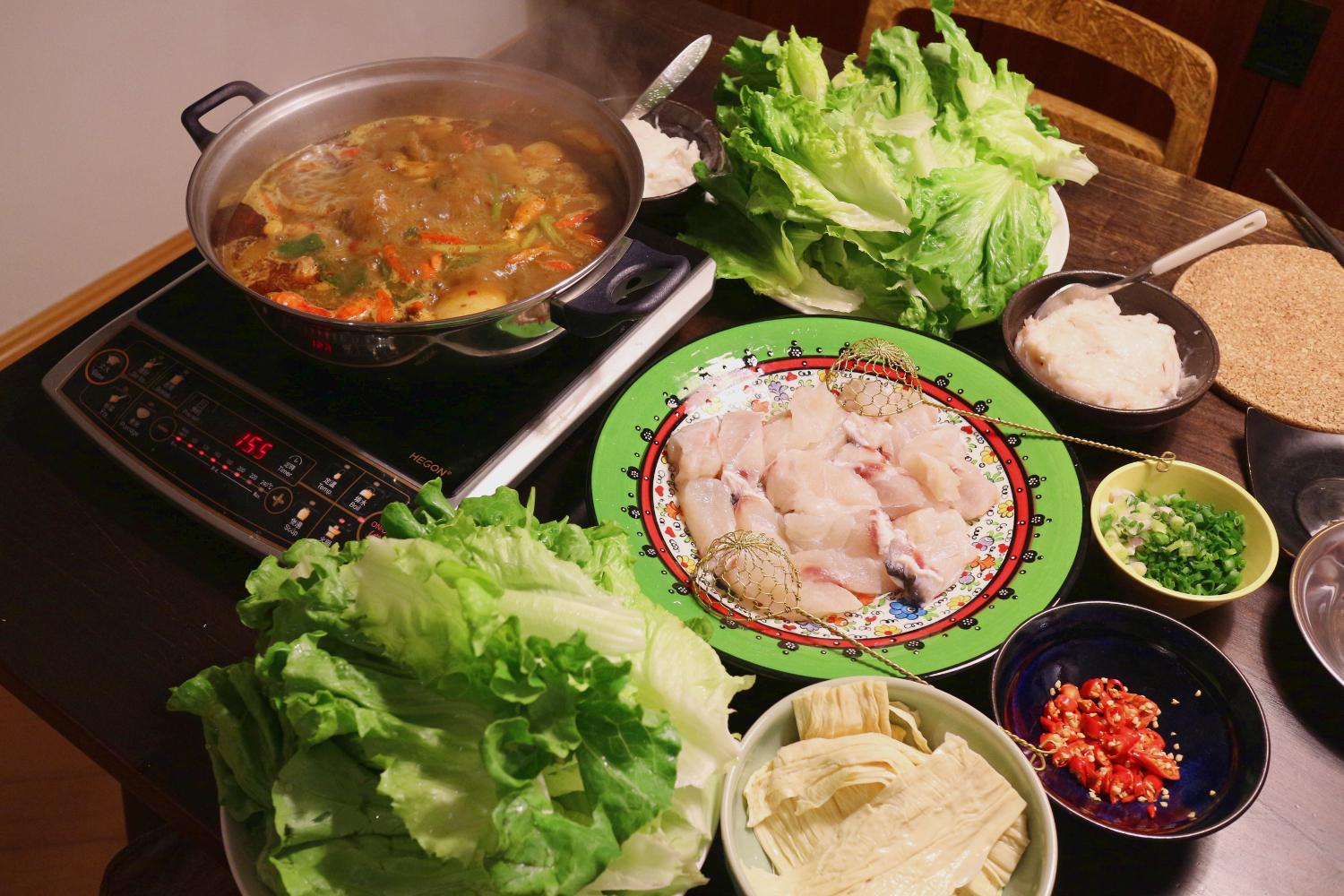
A jovial triathlon of cooking, eating and chatting, hotpot (aka steamboat) involves dipping fresh slivers of food into vats of simmering broth, then eating with your condiments of choice. The broth can be a modest tofu soup or an exotic tongue-burner, and just about everything in between. Ingredients – easily over a hundred – cover all manner of fresh seafood, meat and vegetables, that may include paper-thin geoduck slices, silken beancurd robes, and ubiquitous 'balls' made of fish, shrimp or cuttlefish meat bound with egg and corn starch.
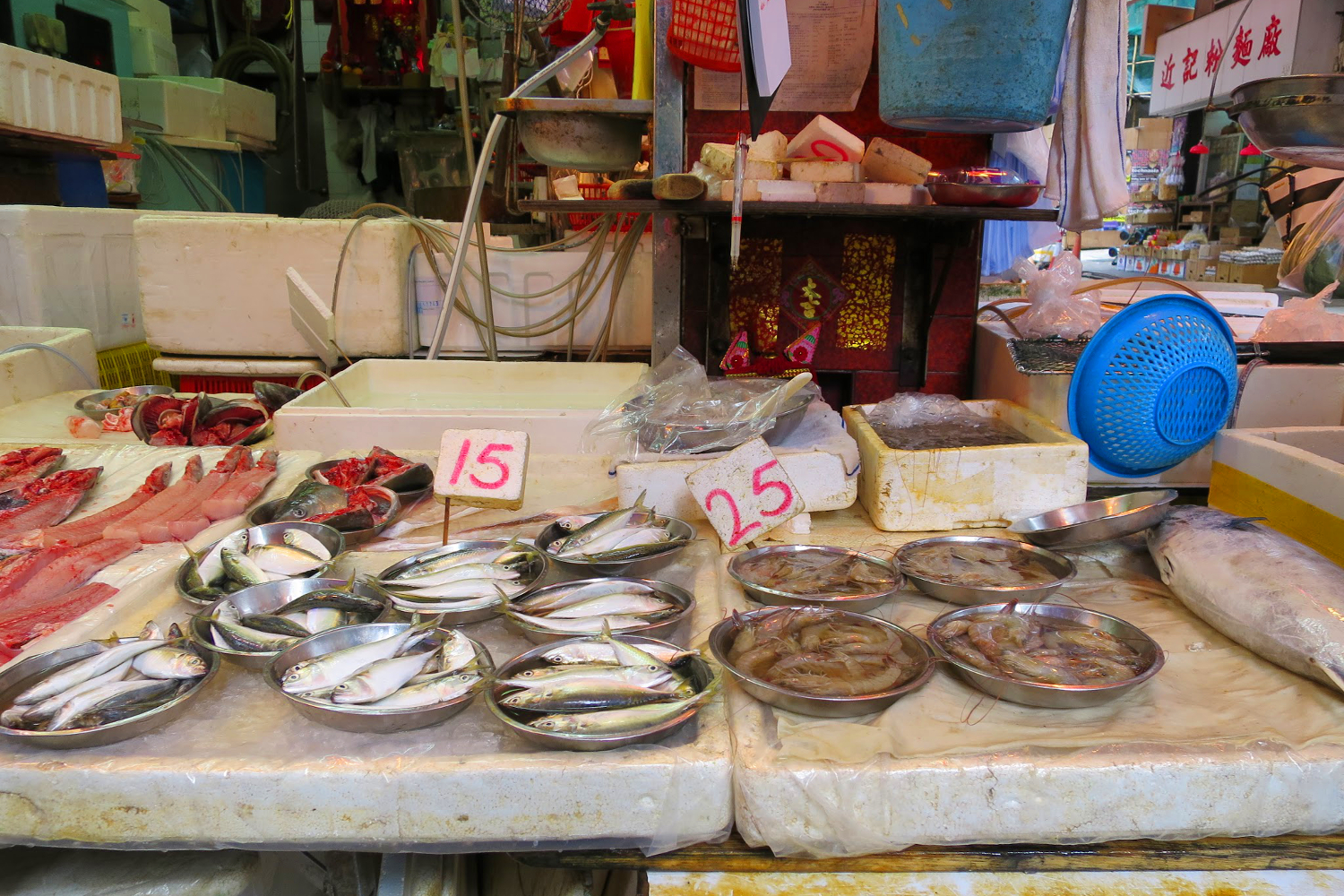
The Cantonese obsession with freshness makes Hong Kong one of the best places in the world for seafood. Restaurants have tanks where marine creatures are ready for quick cooking. Simple cooking techniques are favoured as they allow the seafood to retain its sweetness. Fish is steamed whole until just done, then topped with scallion julienne, over which hot oil and seasoned soy sauce is poured. Scallops are briskly sautéed with asparagus or steamed on the half-shell with minced garlic and a twirl of glass noodles. Shrimp blanched 'till just orange are eaten plain or with a touch of chilli-laced soy sauce.
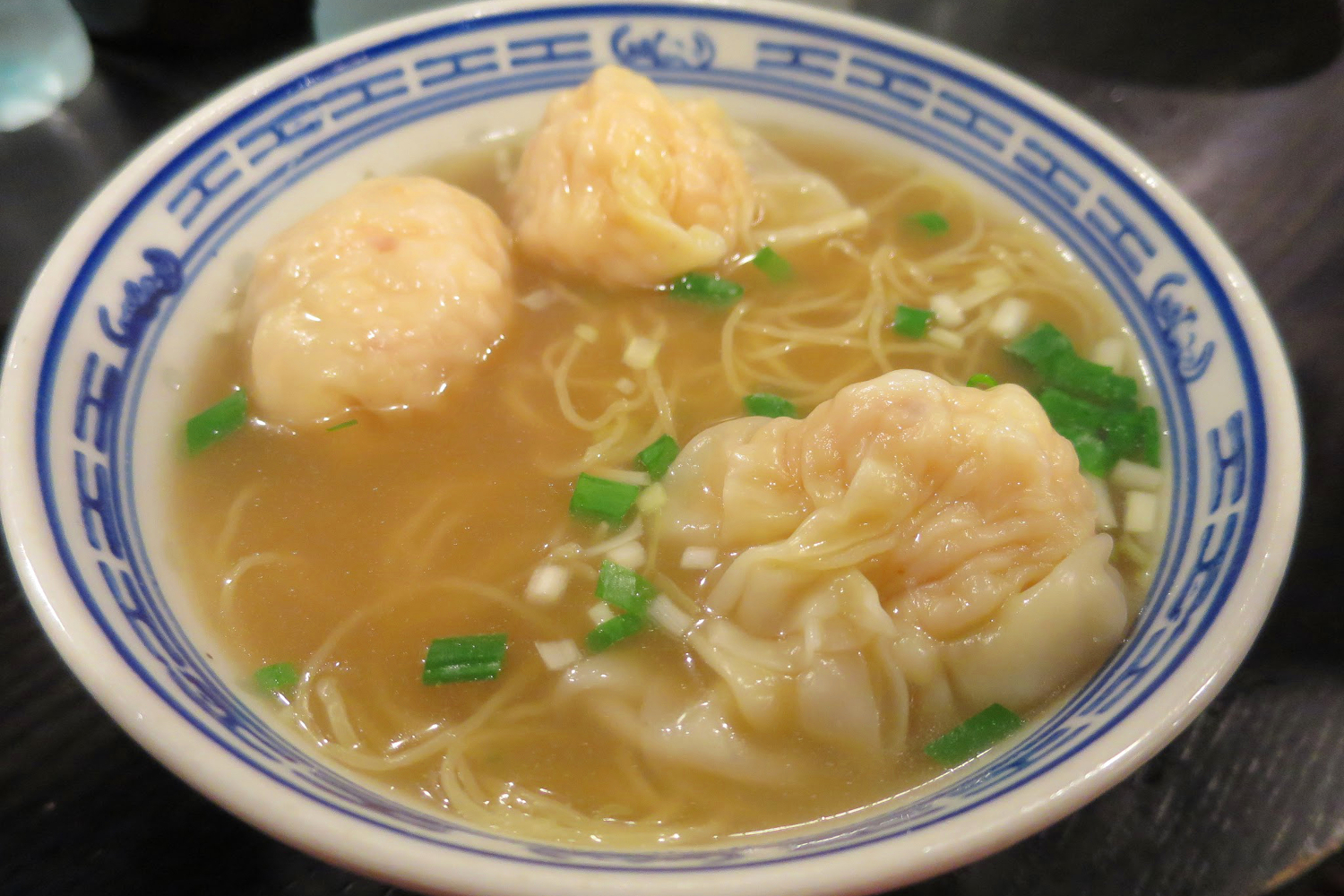
For many Hong Kongers, a bowl of wonton noodles comforts like nothing else. Cantonese-style wontons are tiny whirlwinds of minced pork and shrimp in yellow wrappers that trail in the broth, giving the them the look of clouds in a Chinese painting. The thin, yellow noodles are made with duck eggs and an alkaline mixture that heightens their springiness and slipperiness. In traditional shops, the dough is kneaded with a huge bamboo pole, which makes them even more al dente. They’re delicious in soup or tossed with a side of hearty braised beef brisket.
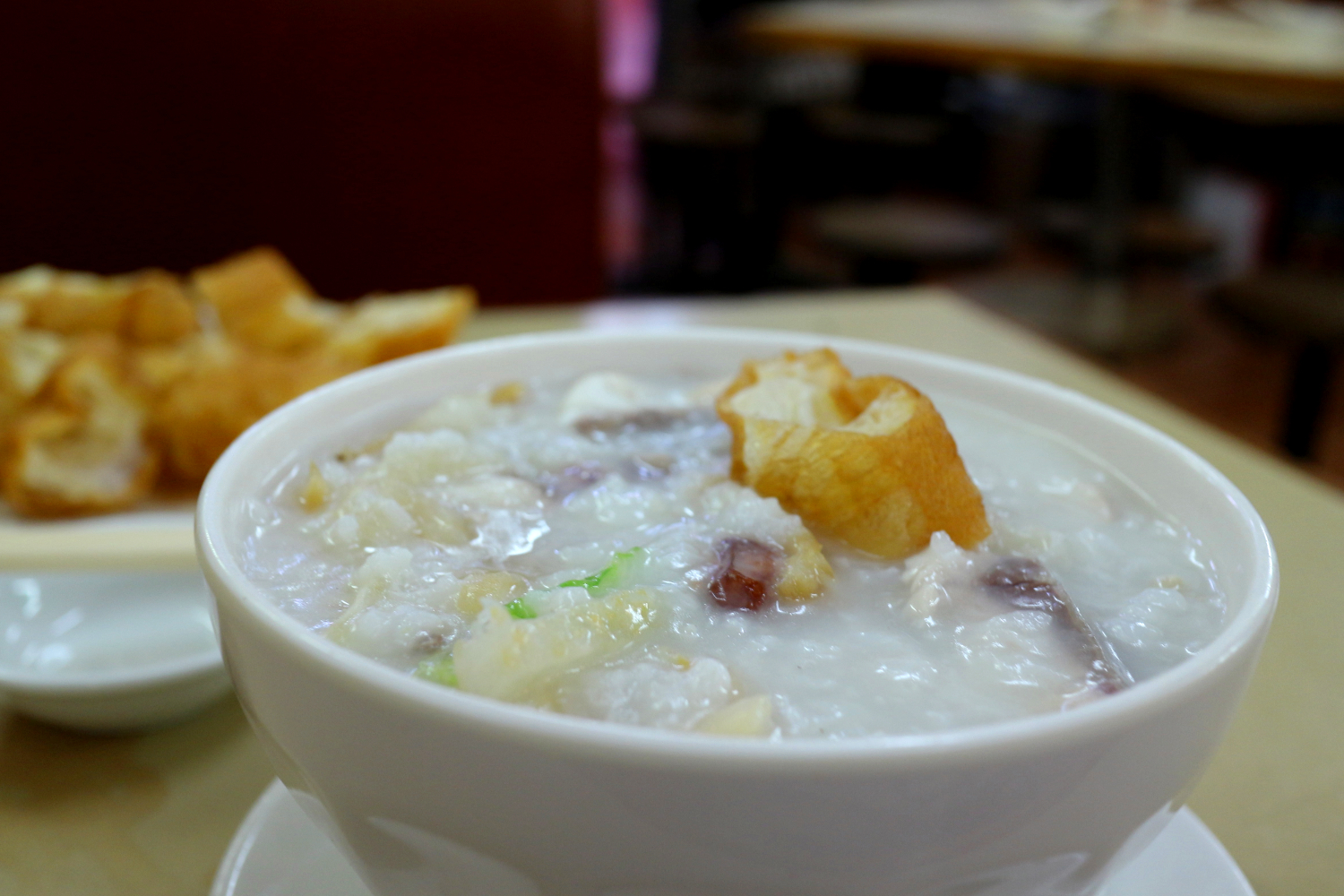
A Hong Kong staple, congee is rice and water (or broth) simmered for hours, sometimes with gingko nut and dried scallop thrown in. The result is a smooth gruel that tastes delicious and calms the stomach. Plain congee is fed to those who are ill. But it’s usually flavoured – with chunks of juicy fish belly, seasoned liver, shredded pork, dried oysters, or salted egg. It’s perfect for dipping too. Choose between savoury Chinese crullers (yau tiu) or sweet and chewy ‘ox-tongue’ doughnuts (ngau lei so) – golden-brown pastries that materialise in frying woks at dawn and vanish by noon.
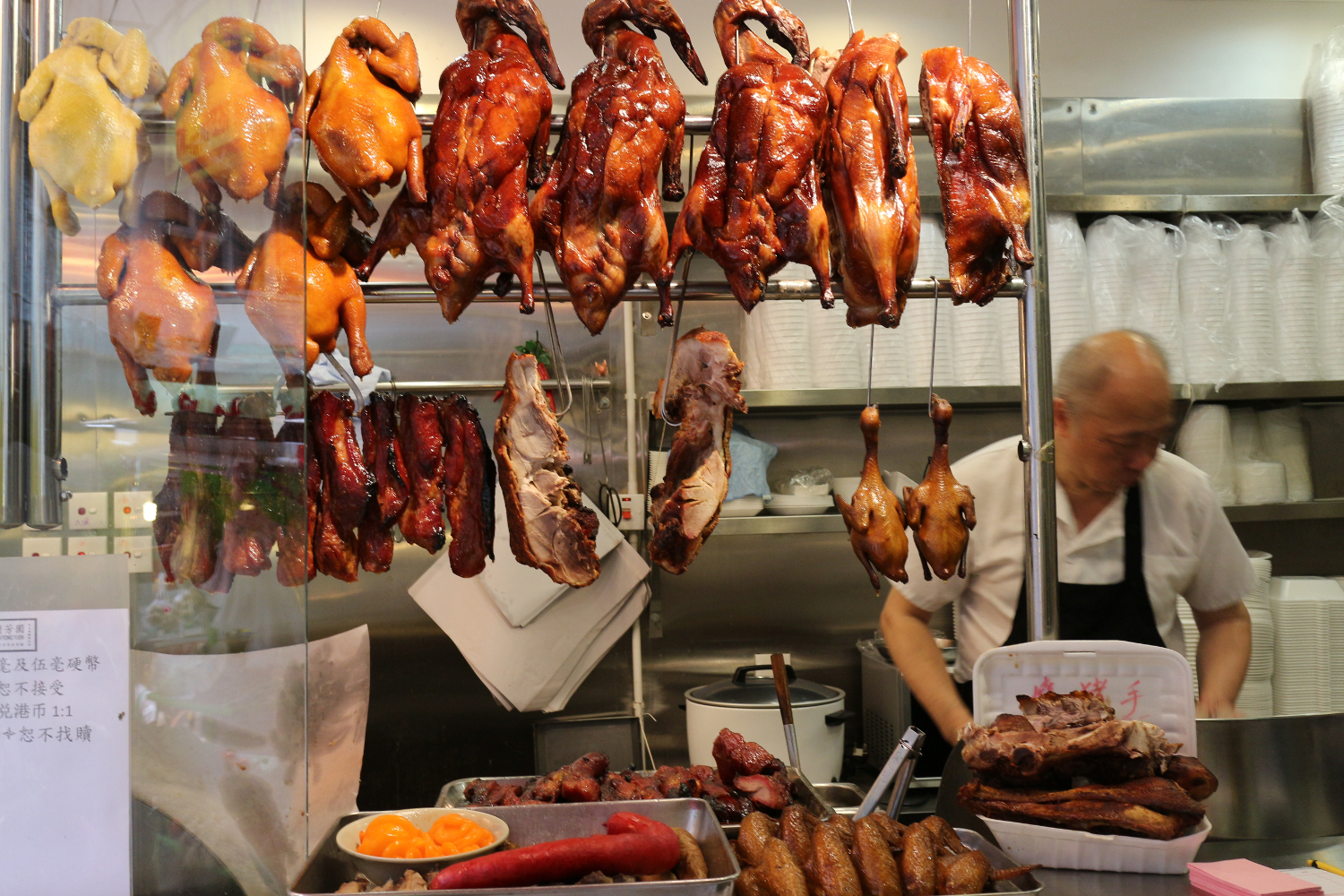
You’ll see Cantonese-style roasted meats (siu mei) all over Hong Kong – seasoned joints of pork or fowl glistening seductively from hooks in stalls and markets, or lounging on chinaware at fancy restaurants. Barbecued pork (cha siu) is succulent cuts of glazed pork that have been seasoned with spices, wine and a plethora of other condiments. When a (slightly fatty) cut is done right, it’s divine – beautifully charred on the outside, and smoky and unctuous on the inside. Another favourite is roasted suckling pig (siu yue ju): the skin is crackled just prior to serving to make sure it’s hot and crisp.
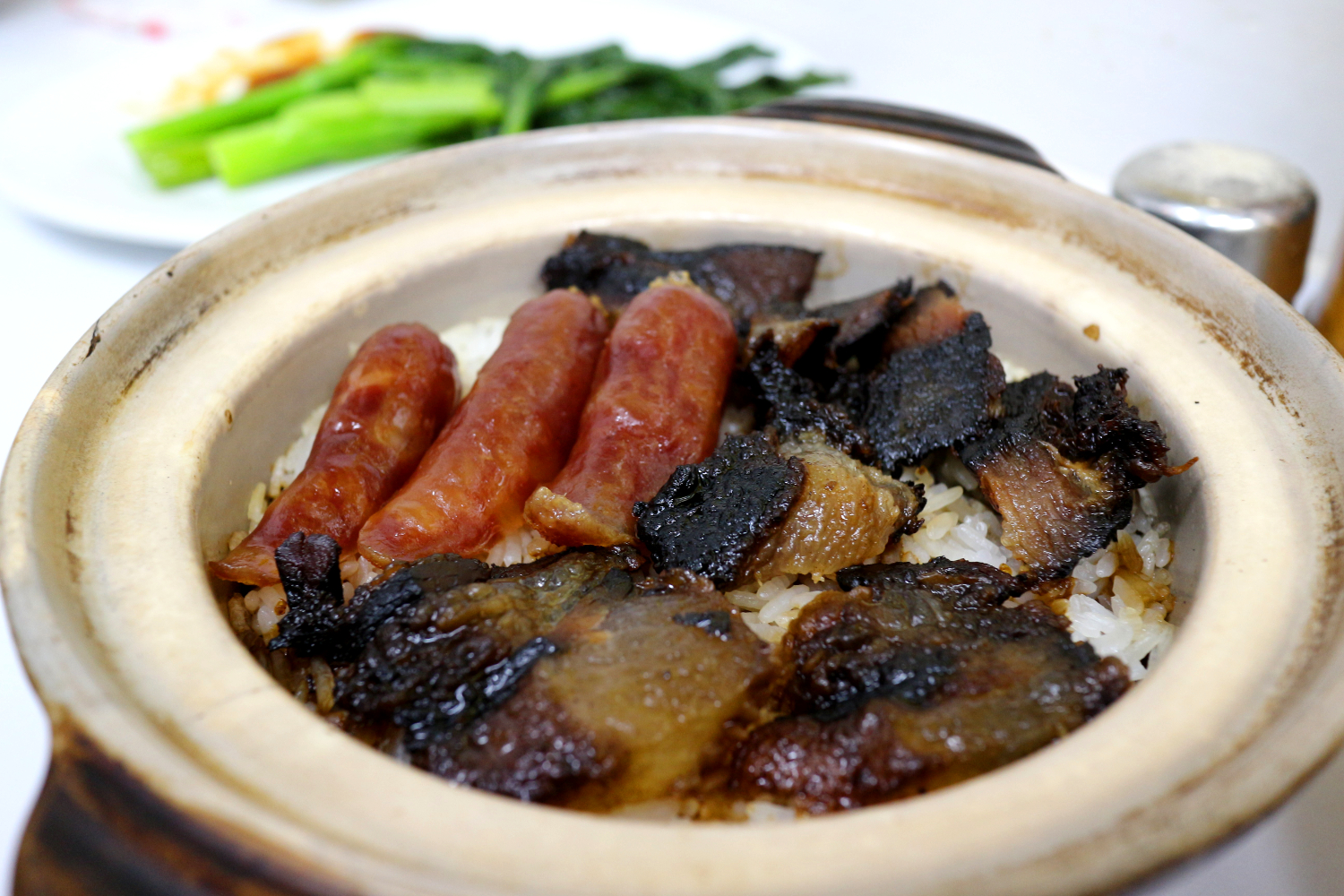
To make bo tsai fahn, rice and a variety of fresh and cured meats are cooked in claypots over charcoal or gas stoves until the grains are infused with the juices of the meat, and a layer of rice crackle is formed at the bottom of the pot. Toppings come in many combos; the most popular are minced beef and egg, chicken and dried mushroom, white eel and pork sausage. Wine-infused Chinese dried sausages are the essence of a claypot meal – hard and red lap cheong (pork sausage) or soft and dark yun cheong (duck liver sausage). Seasoned with rose water and liberally sweetened, they lend a distinctive fragrance to the rice: an unmistakable smell of a Hong Kong winter.
Crispy fried chicken (tsa zi gaai) exemplifies the Cantonese fondness for using complex culinary methods to make seemingly simple dishes. The dish, which takes more than a day to prepare, involves subjecting a freshly slaughtered fowl to steeping, drying, basking, air-drying and double-frying. The painstaking process results in crisp, paper-thin skin, and meat that’s still juicy and tender.
In need of dining partners so you can make the most of your epicurean adventure? Consider joining one of the city’s organized food walks, such as Hong Kong Foodie Tours or Little Adventures in Hong Kong .
Want even more drool-inducing Hong Kong food inspiration? Check out our video on the cheapest Michelin-starred restaurant in the world.